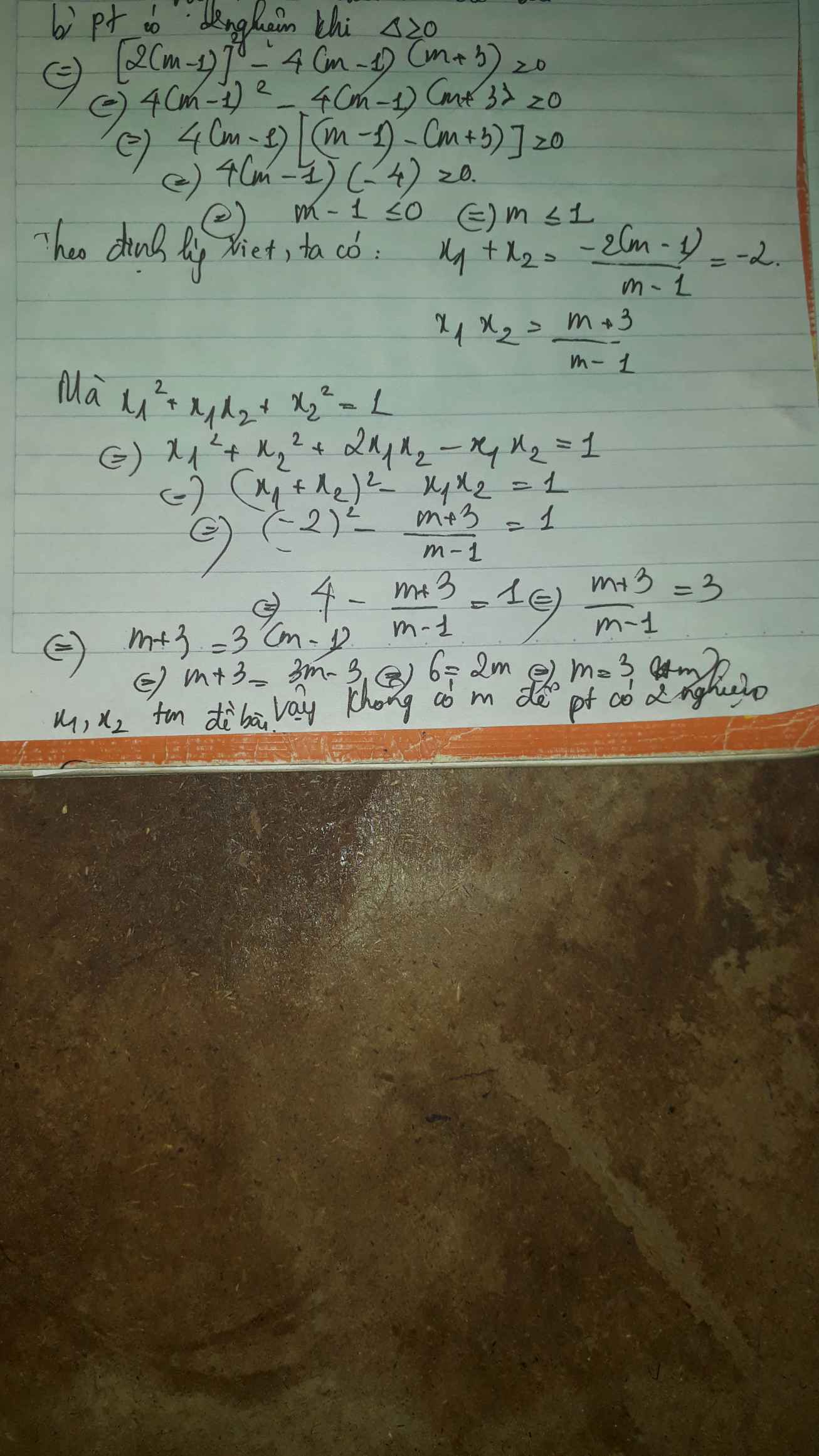Hãy nhập câu hỏi của bạn vào đây, nếu là tài khoản VIP, bạn sẽ được ưu tiên trả lời.

\(\Delta'=\left[-\left(m+1\right)\right]^2-\left(m^2+m\right)=m^2+2m+1-m^2-m\)
\(=m+1\)
pt có nghiệm x1,x2 \(< =>m+1\ge0< =>m\ge-1\)
vi ét \(=>\left\{{}\begin{matrix}x1+x2=2m+2\\x1x2=m^2+m\end{matrix}\right.\)
a,\(=>2m+2=m^2+m< =>m^2-m-2=0\)
\(a-b+c=0=>\left[{}\begin{matrix}m1=-1\\m2=2\end{matrix}\right.\left(tm\right)\)
b,\(< =>3\left(2m+2\right)-2\left(m^2+m\right)-1=0\)
\(< =>-2m^2+4m+5=0\)
\(ac< 0\) pt có 2 nghiệm pbiet \(=>\left[{}\begin{matrix}m1=...\\m2=...\end{matrix}\right.\) thay số vào tính m1,m2 đối chiếu đk

Để phương trình có 2 nghiệm x1,x2
\(\Leftrightarrow\Delta=\left(m-2\right)^2-4\cdot\left(-2m\right)\ge0\)
\(\Leftrightarrow m^2-4m+4+8m\ge0\)
\(\Leftrightarrow\left(m+2\right)^2\ge0\) (luôn đúng)
Theo định lí Vi-ét:
\(\left\{{}\begin{matrix}x_1+x_2=m-2\\x_1x_2=-2m\end{matrix}\right.\)
Kết hợp định lí Vi-ét và đề bài ta có điều kiện:
\(\left\{{}\begin{matrix}x_1+x_2=m-2\\2x_1+3x_2=0\end{matrix}\right.\)\(\Leftrightarrow\left\{{}\begin{matrix}x_1=m-2-x_2\\2\left(m-2-x_2\right)+3x_2=0\end{matrix}\right.\)\(\Leftrightarrow\left\{{}\begin{matrix}x_1=m-2-x_2\\2m-4-2x_2+3x_2=0\end{matrix}\right.\)
\(\Leftrightarrow\left\{{}\begin{matrix}x_1=3m-6\\x_2=4-2m\end{matrix}\right.\)
Cũng theo Vi-ét:
\(x_1x_2=-2m\) \(\Rightarrow\left(3m-6\right)\left(4-2m\right)=-2m\)
\(\Rightarrow-6m^2+26m-24=0\)
\(\Rightarrow\left[{}\begin{matrix}m=3\\m=\dfrac{4}{3}\end{matrix}\right.\)
Vậy \(m\in\left\{3;\dfrac{4}{3}\right\}\) thỏa mãn đề
Tick nha 😘
\(\Delta=\left(m-2\right)^2+8m=\left(m+2\right)^2\ge0;\forall m\Rightarrow\) phương trình đã cho luôn có nghiệm
Theo hệ thức Viet: \(\left\{{}\begin{matrix}x_1+x_2=m-2\\x_1x_2=-2m\end{matrix}\right.\)
Kết hợp hệ thức Viet và điều kiện đề bài ta được:
\(\left\{{}\begin{matrix}x_1+x_2=m-2\\2x_1+3x_2=0\end{matrix}\right.\) \(\Leftrightarrow\left\{{}\begin{matrix}2x_1+2x_2=2m-4\\2x_1+3x_2=0\end{matrix}\right.\)
\(\Leftrightarrow\left\{{}\begin{matrix}x_1=3m-6\\x_2=-2m+4\end{matrix}\right.\)
Thế vào \(x_1x_2=-2m\)
\(\Rightarrow\left(3m-6\right)\left(-2m+4\right)=-2m\)
\(\Leftrightarrow-6m^2+26m-24=0\Rightarrow\left[{}\begin{matrix}m=3\\m=\dfrac{4}{3}\end{matrix}\right.\)

b) phương trình có 2 nghiệm \(\Leftrightarrow\Delta'\ge0\)
\(\Leftrightarrow\left(m-1\right)^2-\left(m-1\right)\left(m+3\right)\ge0\)
\(\Leftrightarrow m^2-2m+1-m^2-3m+m+3\ge0\)
\(\Leftrightarrow-4m+4\ge0\)
\(\Leftrightarrow m\le1\)
Ta có: \(x_1^2+x_1x_2+x_2^2=1\)
\(\Leftrightarrow\left(x_1+x_2\right)^2-2x_1x_2=1\)
Theo viet: \(\left\{{}\begin{matrix}x_1+x_2=-\dfrac{b}{a}=2\left(m-1\right)\\x_1x_2=\dfrac{c}{a}=m+3\end{matrix}\right.\)
\(\Leftrightarrow\left[-2\left(m-1\right)^2\right]-2\left(m+3\right)=1\)
\(\Leftrightarrow4m^2-8m+4-2m-6-1=0\)
\(\Leftrightarrow4m^2-10m-3=0\)
\(\Leftrightarrow\left[{}\begin{matrix}m_1=\dfrac{5+\sqrt{37}}{4}\left(ktm\right)\\m_2=\dfrac{5-\sqrt{37}}{4}\left(tm\right)\end{matrix}\right.\Rightarrow m=\dfrac{5-\sqrt{37}}{4}\)

a)
Ta có: \(\Delta=\left[-2\left(m+2\right)\right]^2-4\cdot1\cdot\left(m-3\right)\)
\(=\left(-2m-4\right)^2-4\left(m-3\right)\)
\(=4m^2+16m+16\ge0\forall x\)
Suy ra: Phương trình \(x^2-2\left(m+2\right)x+m-3=0\) luôn có nghiệm với mọi m
Áp dụng hệ thức Viet, ta được:
\(\left\{{}\begin{matrix}x_1+x_2=2\left(m+2\right)=2m+4\\x_1\cdot x_2=m-3\end{matrix}\right.\)
Ta có: \(\left(2x_1+1\right)\left(2x_2+1\right)=8\)
\(\Leftrightarrow4\cdot x_1x_2+2\cdot\left(x_1+x_2\right)+1=8\)
\(\Leftrightarrow4\left(m-3\right)+2\left(2m+4\right)+1=8\)
\(\Leftrightarrow4m-12+4m+8+1=8\)
\(\Leftrightarrow8m=8+12-8-1\)
\(\Leftrightarrow8m=11\)
hay \(m=\dfrac{11}{8}\)
Tiếp tục với bài của bạn Nguyễn Lê Phước Thịnh
b)
Ta có: \(x_1^2+x_2^2-3x_1x_2=\left(x_1+x_2\right)^2-5x_1x_2\)
\(\Rightarrow P=4m^2+11m+31=4m^2+2\cdot m\cdot\dfrac{11}{2}+\dfrac{121}{4}+\dfrac{3}{4}\) \(=\left(2m+\dfrac{11}{2}\right)^2+\dfrac{3}{4}\ge\dfrac{3}{4}\)
Dấu bằng xảy ra \(\Leftrightarrow2m+\dfrac{11}{2}=0\Leftrightarrow m=-\dfrac{11}{4}\)
Vậy \(P_{Min}=\dfrac{3}{4}\) khi \(m=-\dfrac{11}{4}\)

a. Khi m=2 thì (1) có dạng :
\(x^2-6\left(2-1\right)x+9\left(2-3\right)=0\\ \Leftrightarrow x^2-6x-9=0\\ \Leftrightarrow\left(x-3\right)^2=18\Leftrightarrow x-3=\pm\sqrt{18}\\ \Leftrightarrow x=3\pm3\sqrt{2}\)
Vậy với m=2 thì tập nghiệm của phương trình là \(S=\left\{3\pm3\sqrt{2}\right\}\)
b. Coi (1) là phương trình bậc 2 ẩn x , ta có:
\(\text{Δ}'=\left(-3m+3\right)^2-1\cdot9\left(m-3\right)=9m^2-18m+9-9m+27\\ =9m^2-27m+36=\left(3m-\dfrac{9}{2}\right)^2+\dfrac{63}{4}>0\)
Nên phương trình (1) luôn có 2 nghiệm x1,x2 thỏa mãn:
\(\left\{{}\begin{matrix}x_1+x_2=6\left(m-1\right)\\x_1x_2=9\left(m-3\right)\end{matrix}\right.\left(2\right)\)
Vì
\(x_1+x_2=2x_1x_2\\ \Leftrightarrow6\left(m-1\right)=18\left(m-3\right)\Leftrightarrow m-1=3m-9\\ \Leftrightarrow2m=8\Leftrightarrow m=4\)
Vậy m=4
b) Ta có: \(\text{Δ}=\left[-6\left(m-1\right)\right]^2-4\cdot1\cdot9\left(m-3\right)\)
\(=\left(6m-6\right)^2-36\left(m-3\right)\)
\(=36m^2-72m+36-36m+108\)
\(=36m^2-108m+144\)
\(=\left(6m\right)^2-2\cdot6m\cdot9+81+63\)
\(=\left(6m-9\right)^2+63>0\forall m\)
Suy ra: Phương trình luôn có hai nghiệm phân biệt với mọi m
Áp dụng hệ thức Vi-et, ta có:
\(\left\{{}\begin{matrix}x_1+x_2=6\left(m-1\right)=6m-6\\x_1\cdot x_2=9\left(m-3\right)=9m-27\end{matrix}\right.\)
Ta có: \(x_1+x_2=2x_1\cdot x_2\)
\(\Leftrightarrow6m-6=2\left(9m-27\right)\)
\(\Leftrightarrow6m-6-18m+54=0\)
\(\Leftrightarrow-12m+48=0\)
\(\Leftrightarrow-12m=-48\)
hay m=4
Vậy: m=4

\(\Delta'=9-6m+m^2=\left(m-3\right)^2\ge0;\forall m\)
\(\Rightarrow\) Pt luôn có nghiệm với mọi m
Theo hệ thức Viet: \(\left\{{}\begin{matrix}x_1+x_2=-6\\x_1x_2=6m-m^2\end{matrix}\right.\)
Do \(x_1\) là nghiệm nên: \(x_1^2+6x_1+6m-m^2=0\Leftrightarrow2x_1^2+12x_1=2m^2-12\)
\(x_1^3-x_2^3+2x_1^2+12x_1+72=0\)
\(\Leftrightarrow\left(x_1-x_2\right)\left[\left(x_1+x_2\right)^2-x_1x_2\right]+2m^2-12m+72=0\)
\(\Leftrightarrow\left(x_1-x_2\right)\left(m^2-6m+36\right)+2m^2-12m+72=0\)
\(\Leftrightarrow\left(x_1-x_2+2\right)\left(m^2-6m+36\right)=0\)
\(\Leftrightarrow x_1-x_2+2=0\) (do \(m^2-6m+36=\left(m-3\right)^2+27>0;\forall m\))
Kết hợp với \(x_1+x_2=-6\) ta được:
\(\left\{{}\begin{matrix}x_1-x_2=-2\\x_1+x_2=-6\end{matrix}\right.\) \(\Rightarrow\left\{{}\begin{matrix}x_1=-4\\x_2=-2\end{matrix}\right.\)
Thế vào \(x_1x_2=6m-m^2\)
\(\Rightarrow8=6m-m^2\Rightarrow m^2-6m+8=0\Rightarrow\left[{}\begin{matrix}m=2\\m=4\end{matrix}\right.\)

a: Để phương trình có hai nghiệm trái dấu thì \(\left(m^2-m-6\right)\cdot1< 0\)
\(\Leftrightarrow\left(m-3\right)\left(m+2\right)< 0\)
\(\Leftrightarrow-2< m< 3\)


Cách ngắn ngọn nhất:
\(x^2-2\left(m+1\right)x+4m=0\left(1\right)\)
\(\Leftrightarrow x^2-2x-2mx+4m=0\)
\(\Leftrightarrow x\left(x-2\right)-2m\left(x-2\right)=0\)
\(\Leftrightarrow\left(x-2\right)\left(x-2m\right)=0\)
\(\Leftrightarrow\left[{}\begin{matrix}x=2\\x=2m\end{matrix}\right.\)
Phương trình (1) có 2 nghiệm là \(x=2;x=2m\). Mặt khác phương trình (1) cũng có 2 nghiệm là x1, x2 nên ta chia làm 2 trường hợp:
TH1: \(x_1=2;x_2=2m\).
Có \(2x_1-x_2=-2\Rightarrow2.2-2m=-2\Leftrightarrow m=3\)
TH2: \(x_1=2m;x_2=2\)
Có \(2x_1-x_2=-2\Rightarrow2.\left(2m\right)-2=-2\Leftrightarrow m=0\)
Vậy m=0 hay m=3
Cảm ơn bạn nhiều ạ